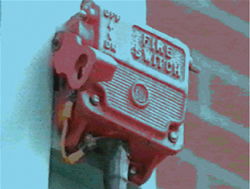As a result of the introduction of the 17th Edition of the Wiring Regulations, it has been necessary to revise the series of Guidance Notes published by the IEE to accompany the Wiring Regulations so that their content relates to the current requirements of both BS 7671 and relevant statutory legislation.

Since BS 7671 was last amended (in March 2004) significant changes have occurred in a number of Statutory Instruments which have a direct influence on its content. One such change was the introduction of the Regulatory Reform (Fire Safety) Order in 2005.
This article briefly introduces this Order and summarizes some of the requirements therein which have an influence on those involved in electrical installation and maintenance. It also looks at in particular the requirements for firefighters’ switches contained in both the Order and BS 7671: 2008 to highlight the relationship between the statutory and non-statutory requirements they contain respectively relating to this topic.
THE REGULATORY REFORM (FIRE SAFETY) ORDER 2005
The Regulatory Reform (Fire Safety) Order 2005 (henceforth referred to as the Order) has a direct influence on many other pieces of primary and secondary statutory legislation, requiring
modifications and, in some cases, partial or full revocation of the requirements therein. It replaces fire certification under the Fire Precautions Act 1971 with a general duty to ensure, so far as is reasonably practicable, the safety of employees and a general duty, in relation to non-employees to take such fire precautions as may reasonably be required to ensure that premises are safe.
The Order came into effect fully in October 2006 and has an effect on over 70 pieces of fire safety legislation. It applies to nondomestic premises in England and Wales, including any communal areas of blocks of flats or houses in multiple occupation and places a number of legal obligations and responsibilities upon the individual identified therein as the responsible
person.
The responsible person has duties placed upon them to:
- carry out a risk assessment to confirm that any fire safety precautions in place within the premises are adequate (article 9). It also requires this risk assessment to be regularly updated
- take the necessary general fire precautions (article 10)
- make arrangements for planning, organisation, control, monitoring and review of preventative and protective measures (article 11)
- ensure that premises under their control are adequately equipped with fire-fighting and fire detection / alarm equipment (article 13)
- maintain the accessibility of escape routes to emergency exits at all times; confirm that emergency exits lead as directly as possible to a place of safety; ensure that emergency doors open outwards; and confirm the adequacy of provision of indication signs and emergency lighting arrangements (article 14)
- put in place and keep up a suitable maintenance regime to ensure any equipment provided for the purposes of fire safety remains functional (article 17)
- appoint competent persons to assist them to comply with their duties under this Order(article 18)
- put in place and provide adequate safety training (article 21)
To view the full article from the IET's Wiring Matters Summer 2008, click on the attachment below...
